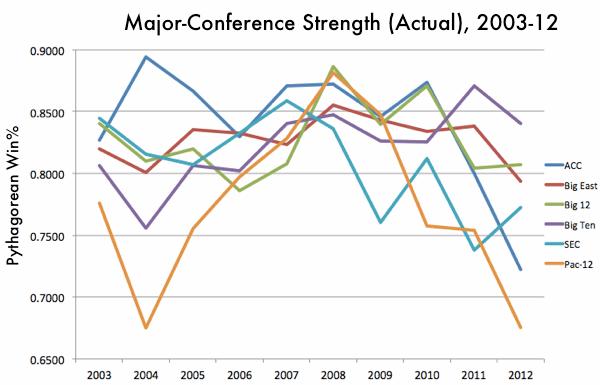
By The Numbers: Big East, Pac-12 take hits as realignment rages on
What I aim to do, at least before Clemson and Florida State get lassoed up by the Big 12, is use the 2013-14 alignments to forecast a new conference pecking order in college basketball. Will there still be six dominant leagues, cycling in and out of power? Will the gains made by a few conferences offset the losses of others?
My preferred measure of conference strength is using the Pythagorean expectations formula from kenpom.com, which averages the adjusted offensive and defensive efficiencies for an entire league, and generates a projected winning percentage. (There are other, less scientific methods -- say, comparing leagues' NCAA tournament bids and wins each season -- but this is the best way to gauge top-to-bottom quality of play.) The idea is to compare what actually happened over the past 10 seasons against what the stats say would have happened, had the past 10 seasons played out under the new alignments. Would the realigned Big East have been in the same ballpark as the actual Big East? No, it turns out, not at all.
The first chart compares the actual strength of the six power conferences from 2003-12. Although the ACC was the elite league on four occasions, and the Big Ten ruled the past two seasons, there was plenty of variation:
The next step is to make the following edits to conferences' membership, and then play out each season as if the realigned teams were in their 2013-14 places:
ACC: Adds Pittsburgh and Syracuse.
Big East: Loses Pitt, Syracuse and West Virginia; adds Houston, Memphis, SMU, Temple and UCF.
Big 12: Loses Missouri, Texas A&M, Colorado* and Nebraska*; adds West Virginia and TCU.
Big Ten: Adds Nebraska*.
SEC: Adds Missouri and Texas A&M.
Pac-12: Adds Colorado* and Utah*.
(* Change already in effect for 2011-12 season.)
There are some significant developments, the first one being that that Pitt-Syracuse combo lifts the ACC into top position for eight out of 10 seasons:
The Big Ten and Pac-12 get slightly worse, as the Big 12 suffers a more noticeable drop and the Big East takes such a huge, awful hit that it only cracks the .800 mark once in 10 years, and never finishes higher than the fourth-best conference. Its lows aren't as bad as the Pac-12's, but as a clearer "tiering" of leagues emerges in the above graphic, the Big East is no longer anywhere near elite status.
When leagues like the Big East are forced into standards-lowering membership scrambles, it has a trickle-down effect on the second-tier conferences. College hoops' clear next-four leagues are the Atlantic 10, Conference USA, Missouri Valley and Mountain West, which played out like this over the past 10 years:
Since Conference USA was subject to a previous raid in 2006, losing Cincinnati, DePaul, Louisville, Marquette and St. Louis, its 2003-05 data has been omitted from the graphic. While the Missouri Valley had an excellent run from 2005-08, the Mountain West has been the most consistently good conference, finishing at the lead of this group six out of 10 seasons. But what happens when realignment hits, and the following changes are made?
Atlantic 10: Loses Temple and Charlotte, adds Butler and VCU.
Conference USA: Loses Houston, Memphis, SMU and UCF; adds Charlotte, FIU, Louisiana Tech, North Texas, Old Dominion, UTSA.
Missouri Valley: No moves.
Mountain West: Loses Boise State, BYU**, San Diego State, TCU and Utah**; adds Fresno State, Nevada, San Jose State and Utah State.
(* Change already in effect for 2011-12 season.)
What happens is that the Mountain West goes from six tier-leading seasons to just two, while Conference USA drops off so severely that it's the worst league every year from 2006-on:
You can survive getting raided once -- what the Atlantic 10 did, actually making itself better by grabbing Butler and VCU, plus creating Butler-Xavier and VCU-Richmond rivalries, should be viewed as a coup -- but you can't survive getting raided twice. RIP, C-USA.
The data suggests that among the 10 leagues I examined, there are five post-realignment tiers (arranged by color), rather than a strict cut-off between majors and mids. The Big East is a decidedly third-tier league after losing two powerhouses and adding dead weight in the form of Houston, SMU and UCF:
When assessed purely in terms of gains vs. losses, the realignment picture looks worse. Of the nine leagues whose membership was affected, six became less efficient overall. The ACC is the only conference that made a noteworthy gain -- but that gain was nowhere near the magnitude of the losses suffered by the Big East, Mountain West and (worst of all) C-USA:
This suggests a future in which the strongest conference becomes a bit better by adding two powerhouses, but everyone else stays the same or gets worse -- and the trickle-down effect of realignment on leagues such as the CAA and SoCon has yet to be fully felt. The sport will go on, and no one will cry over the weakening of C-USA, but they will long lament the death of great major-conference rivalries, and that the once-mighty Big East has lost much of its muscle. Thanks, football, for all that you've done.




